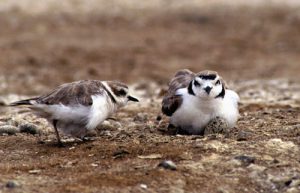 CalAcademy Western Snowy Plover Awareness Training Link
CalAcademy Western Snowy Plover Awareness Training Link
The Pacific coast population of the Western Snowy Plover (Charadrius alexandrinus nivosus), a migratory shorebird, has undergone a dramatic decrease in recent decades largely due to habitat loss, human disturbance and predation. Presently, less than 1500 breeding plovers remain in the Pacific coast population. The plover has been listed as threatened under provisions of the Endangered Species Act.
The Pacific Coast population breeds primarily from March-September, on coastal beaches from Washington to Baja, California often nesting in flat, open sandy areas just in front of coastal fore dunes. Plover nests consist of small, shallow scrapes, often lined with beach debris. Parents incubate the nest for up to four weeks. The plover chicks are percocial, leaving the nest within hours of hatching and following the parents to suitable feeding areas. The parents, primarily the male, will rear the brood until they fledge, approximately four weeks.
Available breeding habitat and nesting success have been significantly reduced due to increased human activity (modification or curtailment of available habitat), beach erosion, and the introduction of exotic plant and animal species such as European beach grass (Ammophila arenaria) and the Eastern red fox. In addition, the breeding season coincides with the greatest recreational use of beaches. Beach visitors can also leave behind garbage that may attract other opportunistic predators such as the striped skunk or American crow.
A large part of the effort to save this species, is to foster a greater public understanding of the plover’s plight. Learning about safely sharing the beach with the plover, and other wildlife, will help maintain the diverse and sensitive habitat along the coast. This can be achieved, in part, through greater compliance with existing regulations, including dog leash laws and nesting area closures. We all have a role to play in the recovery of this species.
California State Parks has implemented new policies and restrictions on state beaches as part of the expanding effort to protect the western snowy plover. Some measures will result in additional restrictions on visitor use in areas that provide important plover habitat, particularly nesting areas. This includes enforcement of existing regulations prohibiting dogs on state beaches. The new rules do not prohibit leashed dogs in campgrounds, picnic areas, parking areas and roads, where dogs are allowed under state regulations. Salmon Creek Beach and Bodega Dunes Beach are protected areas for the snowy plover. Dogs and fires on these beaches are prohibited.
State Parks will limit disruption of public use as much as possible, but at the same time maximize its protective efforts for the threatened shorebird. It has been implementing site protection and enforcement at many plover nesting areas for years. However, more areas will be afforded protection by the expanded effort set forth in the new management program.

